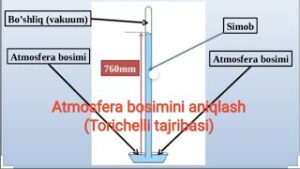SHARE WITH FRIENDS:
ATMOSPHERIC PRESSURE
The weight of the atmosphere is a million times less than the weight of the earth
but it presses the surface of the earth with great force. On the surface of the earth
one cubic meter of air weighs 1 kg 330 g. Air is on the surface of the earth
it presses with a force of about 10 tons per square meter. Man
if we consider the average surface of the body to be one and a half square meters, then 15 tons of force presses on the human body. Atmospheric pressure is equal to 760 mm Hg at ocean level. In recent years, according to the proposal of the Norwegian scientist Bekries, 1 units of force divided by 1000000 cm square have been accepted as a standard unit, and this unit is called "bar".
If the average air pressure at sea level is 1013,2 mb (760 mm),
the air rising above the sea level becomes rarer and its pressure
decreases. The height required to increase the pressure by 1 mm is called the barometric step. In the lower part close to the surface of the earth, the pressure decreases by about 10 mm for every 1 meters of elevation.
At the top of the atmosphere, the barometric pressure increases. Atmospheric pressure is measured at meteorological stations using a barometer placed inside a meteorological box 2 meters above the ground.
Barometers are mercury or aneroid.
